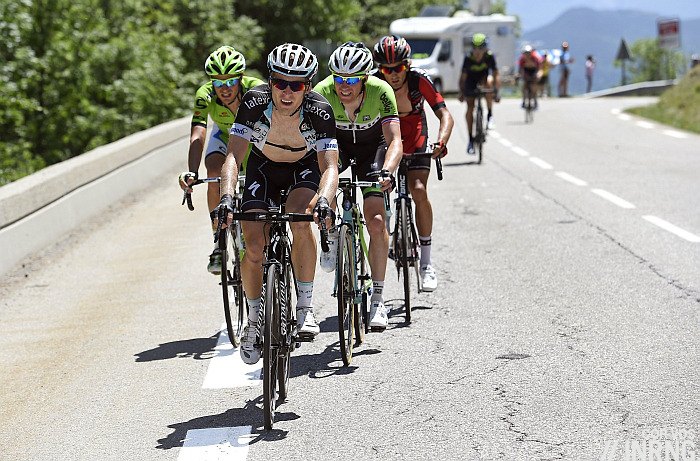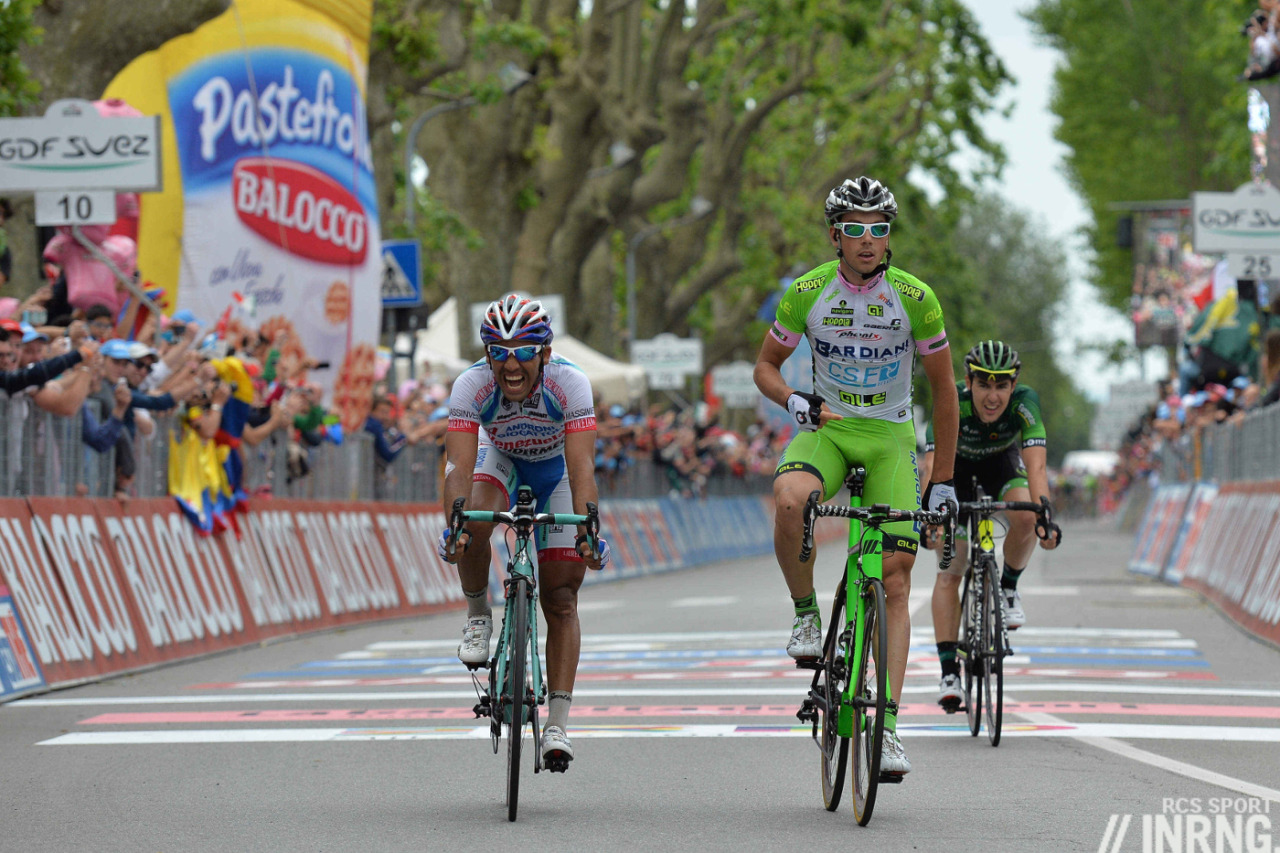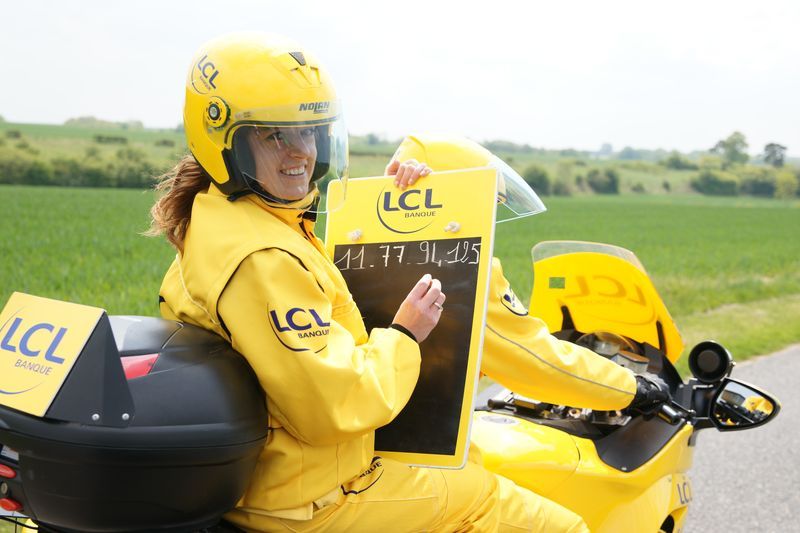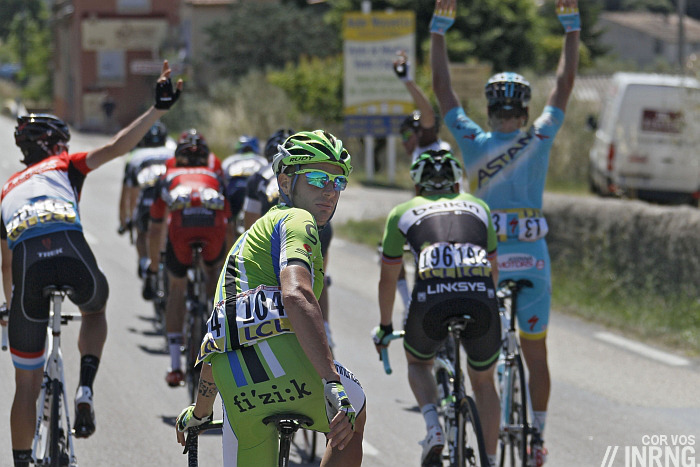
With the Dauphiné having arrived in a town called Gap what better time to talk about the science and art of managing a breakaway?
Everything about a breakaway says freedom, liberty and space. But as well as a hard physical effort it’s also a tricky game of poker with bluff and counter-bluff and the bigger the race, the greater the tactics.
Classic scenario
The race starts and some riders jump away to establish a lead. The fugitives are identified, either on sight by riders or via race radio and once the composition of the breakaway is decided the bunch can decide whether to let them go or try a chase.
For a move to have a chance of making it to the finish there are several ingredients are suggested. None are sufficient but they’re often necessary:
- strong riders: it’s not enough to see names nobody has heard of going up the road, you need some big engines. It sounds obvious when you read it but it’s still helpful to spell out
- strength in numbers: a large group is able to share the work. Also the more riders up the road, the fewer the teams in the bunch who need chase. The reverse is true, a solo breakaway is always a challenge.
- the course: a hilly or awkward route makes an organised chase harder
- the finish: a flat finish for the sprinters or a large summit finish have something in common as there are specialist riders backed by dedicated workers to set up their team leader for these kind of finishes which means a concerted chase
- GC standing: riders who pose no threat to the race leadership are given their day; to a lesser extent the team prize can also come into play, if three riders from one team go up the road other teams won’t be happy.
All these factors in establishing the breakaway and gauging its chances of success. But next comes the tactical component which is harder to view from the outside. For simplicity’s sake let’s talk of the bunch and the breakaway, even if “the bunch” is split between a few teams with an interest in chasing and many who are content to sit tight.
The breakaway knows the bunch is stronger and that typically any lead given away can be reclaimed later on. A group of six riders left to marinate for half the day are going to be easy to pull back once several teams start working, the numbers toiling on the front of the bunch will exceed those working in the breakaway. Think of it as two time trials with one squad of 15 riders versus another of six.

But like all fugitives trying to outrun the law, the breakaway knows they’re outnumbered so they have to resort to tactics. Ideally as they enter the last 50km they’ll begin to soft-pedal. The bunch then gets the information that the time gap is falling. This has two consequences:
- the bunch will judge its pacing knowing the gap is coming down and you don’t want to catch a group too soon otherwise another will surge up the road
- the breakaway are not pacing themselves in a linear effort to the finish instead the slight reduction in pace means they can keep a little in reserve for the finish so that just when the break thinks it can reel them in with 10km to go, the breakaway riders can up the pace and ruin the chasers’ calculations to stay away
Both groups know very well what the other is doing, creating a tactical contest that students of Game Theory might like to model but it’s not easy to analyse. The bunch knows very well the breakaway might ease up a bit only to accelerate. But it’s never so obvious, after all the break is not a team time trial of riders with aligned interests. Some might be soft-pedalling for private reasons to save energy over their companions for day and the group might not be able to conspire to adjust their pace.

At the pro level when information is constantly transmitted. There is the moto blackboard which relays the time gaps but also race radio communicates information to the teams who then relay the updates via their radios. There are two more sources of time gap info, first the TV as many team cars have TV screens and can get the GPS time gap. In addition a team with car behind the breakaway and another behind the bunch can also take private time checks.
It’s this constant supply of information communication that makes a breakaway in a pro race very different from other events. For example in an U23 event it can be common for the strongest riders to club together and simply ride off knowing that a chase can be hard to organise and measure.

Case Study
Today’s Dauphiné stage win by Yuri Trofimov is a good case study. It worked thanks to a powerful group of riders and because there were no sprinters teams chasing to set up the rider, they were deterred by the Col de Manse.
The breakaway contained Andriy Grivko (Astana), Christian Meier (Orica-GreenEdge), Imanol Erviti (Movistar), Maxime Bouet (AG2R), Romain Sicard (Europcar), Pim Lightart (Lotto), Gustav Larsson (IAM), Damiano Caruso (Cannondale), Bob Jungels (Trek), Peter Velits (BMC), Yuri Trofimov (Katusha), Jan Bakelants (OPQS) and Lars-Petter Nordhaug (Belkin). All are strong riders and there were some big engines in there.
Summary
The chances of a breakaway making it to the finish are often low but many still want to try. The odds increase substantially given the right circumstances. But even on those days when the break looks to have no chance there are tactical games to play, notably for the breakaway to signal to the bunch that the chase is working only to accelerate in the final. Watch closely next time a move is away to see if you can spot this.

Have race radios changed the tactics? I suspect that the constant monitoring and relaying of the gap has led to the tactic you describe in which the breakaway ease up, knowing the peloton will do likewise so as to avoid an early catch. Before race radios, when time gaps were less frequently relayed and were always many minutes out of date (rather than essentially real time, as now), such a tactic was less successful, and the breakaway simply had to do the best job it could in expending all its resources as evenly as possible before the line.
tom
Very good piece, very insightful.
One thing that always puzzles me is the role of the escapees’ teammates. When the peloton is slowing down to keep the break at a prudent distance, isn’t it time for those (well sheltered so far) teammates to attack and try to bridge that distance?
It would be counter-productive by provoking a reaction from the rest of the peloton. Best not to poke the sleeping beast with a stick.
That’s the point. Force the bunch to accelerate right now, and therefore catch the break sooner than planned or else let the break go, reinforced in numbers.
It’s generally seen as bad form for team mates to chase a break once it has gone away. There are very few exceptions to this rule. That’s true at both an amateur and professional level.
The team mates could provide a bridge. But obviously they can go once the break is brought back, although never easy in a sprint finale with the high speed.
It is interesting that your excellent article only confirms the premise that present day racing is controlled to a greater extent by radio communication. The resultant scenario normally being very predictable – its not rocket science. If riders were allowed to make their own judgments on the road, results would probably lead to more exciting viewing and unpredictable results.
My personal view would be to ban radios and reduce the size of teams in major tours to enhance the racing experience.
It’s still a skill left to the riders. Team managers can communicate but a good rider will try to do it without the team car.
I am not sure I agree INRNG. I can only think of Tommy V who regularly tears out his radio connection and does his own glorious thing. He is not generally well liked by other riders for his maverick riding, but it certainly makes for an interesting spectacle.
Maybe I’m a cynic but I feel TV’s dramatic approach is more about TV (the medium and the person) than it is about anything else.
Nice piece! Articles like this are what set you well aside and above the mainstream. Thank you.
There is one other consideration – individuals with a hair up their rear. Consider a grumpy DS. This is not so much an issue on Grand Tours, but in one week tours we find that an occasional DS will tell his team: ‘You lot suck this week! One of you had better get in the break or YOU WILL ALL suffer in pulling it back.’ That results in an imbalance. Anyone from the team no matter how good the engine will get into a break and perhaps make it weaker. Then the whole team goes into hiding in the pack, making the break a little more likely to succeed.
This is not meant to be glib, but to observe that the needs of a team go beyond supporting a win in a sprint or mountain stage. Charley W asked his Garmin team to blow up a stage in the Tour, and the result was chaos for many other riders and a win for Dan Martin. Radios make for a higher level of homogeneity in the pack, but Tommy V and Charley W and Shut Up Legs Jens will always be replicated by riders who have their own minds and own agendas. This is why I still watch pro racing, for the individuals who say, more or less: ‘Screw the standard practice for this year, lets make a race!!!’ I don’t do it to see them, but to see how the race revolves around individual action. I find it to be a fascinating sport at that level.
One of the advantages of playing Pro Cycling Manager is knowing the strategic background of a breakwaway!
Other strategical reasons to get into a break could also be:
-To make sure your team doesn’t have to chase. This can be handy for sprinters teams and GC teams. It’s a matter of effort required to get into and be in the break vs. effort required if you’re not and forced to chase.
-To go for secondary classifications: points/KOM/team or even the U25 classification by improving your time.
-To protect your GC team’s position: by having a rider in the break who is relatively high on the GC, you can make sure the break doesn’t stay away until the end.
In the end these strategic motives will impact the motivation of riders to work together (or not!) in the break.
Call me a conspiracy nut, but the cynic in me thinks today we saw a failed deal between Sky and AG2R to let the french team take the yellow jersey for a couple of days.
Ultimately Saxo Tinkoff realised when Sky weren’t trying to close the gap to the virtual leader in the breakaway that Saxo needed to pick up the pace otherwise it would be AG2R riding on the front until the weekend and the Sky domestiques getting a rest.
Froome later said he didn’t mind giving away the yellow jersey. Conspiracy or what the French call “an alliance of circumstances” it could have suited everyone to give the jersey away for a day or two.
It’s interesting how these breakways form, too.
When being out for a race, the WT/CP (+ the local teams) normally hit the front hard at the drop of the red flag. Then we race for 10-30 km with breakaways being caught and other groups trying, the compositions keep changing until someone in the peloton seems to go: “Okay, let’m go…” and they slip away.
Everything then calms down and the race sort of rests in it’s own rythm and pace until the gap is “approved” at a certain timedifference. Then we ride until (the same?) someone decides it is time to reel them in. It is actually quite predictable: The breakaway that goes is escape no. 3 or 4, almost always.
Doing U19 or U23 is way more fun, especially the Juniors. They really are under no control; break, break, break etc. it never stops.
United Healthcare Jones?
Any other guesses?
Thanks for the write up re the breakaway as it’s always been a bit of bugbear that we normally don’t see the start of a stage & your piece shows exactly why we should.
For example, yesterday, live coverage started with the race in a lull and for the next hour we watched the break ride and the peloton follow at a fairly consistant distance. Nothing of any note happened until after Froome had rejoined after a bike change. The first hour however is normally extremely exciting and interesting racing. I know there’s only so much time that tv channels will allot to cycling but on so many days I believe they’d be better to show the first part of the race, until the break is established, on delay and then, go to live pictures.
Better would be the whole stage live of course.
Have seen this over the years when full stages are shown live, usually the Tour. Makes for very entertaining and interesting viewing and you get to see how the eventual break forms. As you say, when live coverage starts its more often than not when the break is established and the bunch is piano.
I’ve been thinking along the same line.
The first time I watched the whole stage was a few years back at the TdF, for over an hour it was nonstop action, break goes, is realed back in, yellow jersey is in 3, 4 group on the road, … great television.
At this years giro they were showing one stage from the start, was looking forward to it, but they started after the break was already established – realy dissapointing.
Another tactic worth mentioning:
During a stage race a breakaway specialist will deliberately lose a heap of time on one of the early stages so that he is given more leeway to get into a break later in the race.
I think, there’s an interesting thing about time gaps not fully understood.
Time gaps are based on marking the time that the Breakaway pass a point, and then marking the time when the Peloton pass the same point, and subtracting one from the other. GPS or “man with watch” is the same basic method.
That has an effect. When the Breakaway put in an extra effort, the observed time gap only starts to grow once the Peloton pass the point where the Breakaway put in the extra effort. The Gap does not grow for many minutes, if the Breakaway has many minutes lead. Likewise if the break slow down, it takes time to see this.
However, If the Peloton puts in an extra effort, the gap reduces immediately. And likewise slowing down.
The other thing that got mentioned after a tour down under stage a couple of years ago was the effort that yah brake put in. I.e. Once you have a certain gap you can reduce your effort in the lull part if the stage as increasing the gap just increases or starts the chase earlier